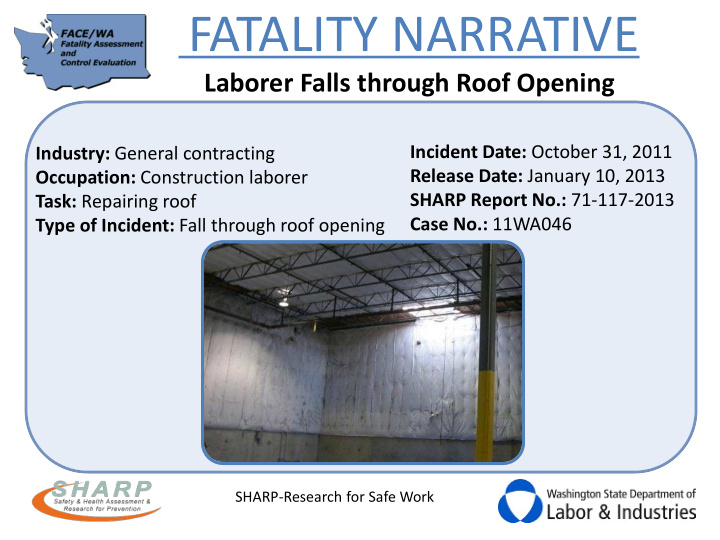



FATALITY NARRATIVE Laborer Falls through Roof Opening Incident Date: October 31, 2011 Industry: General contracting Release Date: January 10, 2013 Occupation: Construction laborer SHARP Report No.: 71-117-2013 Task: Repairing roof Case No.: 11WA046 Type of Incident: Fall through roof opening SHARP-Research for Safe Work
FATALITY NARRATIVE On Oct. 31, 2011, an 18-year-old laborer was fatally injured when he fell through a roof opening. He was an employee of a contractor who was replacing rotten plywood sheathing and joists on a warehouse roof. The victim, a foreman, and another laborer were working on the building’s flat roof tearing out 4’x8’ plywood sections and nailing new ones in place. The victim was wearing a full-body harness with a lanyard and using two lifelines hooked together with one of the lines looped around a skylight frame, which served as an anchor point. The Harness cut from laborer other two employees were not using fall protection. The two laborers were taking nails out of a sheet of plywood they had removed when their foreman asked them to move out of the way so that he could place a new sheet of plywood over the roof opening they had exposed. They were then to nail the plywood in place. When the victim moved aside, he stepped onto two pieces of rotten plywood that were not nailed down, and the plywood pieces and unattached joist supporting them gave way. An investigation determined that his rope grab was attached near the end of his lifeline which left too much slack in the line allowing him to fall 30 feet to a concrete floor. Rope grab at end of rope
FATALITY NARRATIVE Requirements When employees are exposed to a hazard of falling from a location 10 feet or more in height, the • employer must ensure that fall restraint, fall arrest systems or positioning device systems are provided, installed and implemented according to the requirements of WAC 296-155-24510. Employers must develop and implement a fall protection work plan including each area of the • work place where the employees are assigned and where fall hazards of 10 feet or more exist. WAC 296-155-24505(1). The employer must ensure that employees are trained on the fall protection work plan including • fall hazard identification and maintenance, inspection, and disassembly of the fall protection system to be used. WAC 296-155-24505(4)(a). Body harness systems must be rigged to minimize free fall distance with a maximum free fall • distance allowed of 6 feet, and such that the employee will not contact any lower level. See WAC 296-155-24510(2)(a)(v).
FATALITY NARRATIVE Recommendations Employers should • Conduct a daily hazard assessment to identify and eliminate hazards, such as roof • openings and rotten areas of roofs incapable of supporting the weight of employees. Closely supervise and monitor young and less experienced workers. • Consider assigning hazardous tasks to more experienced workers. • Train workers to continually inspect fall prevention systems to ensure they are • protective. Statewide Statistics: This was number 41 of 52 work-related fatalities in Washington State during 2011, and was number 6 of 6 construction-related fatalities. This bulletin was developed to alert employers and employees of a tragic loss of life of a worker in Washington State and is based on preliminary data ONLY and does not represent final determinations regarding the nature of the incident or conclusions regarding the cause of the fatality. Developed by WA State Fatality Assessment and Control Evaluation (FACE) Program and the Division of Occupational Safety and Health (DOSH), WA State Dept. of Labor & Industries. The FACE Program is supported in part by a grant from the National Institute for Occupational Safety and Health (NIOSH). For more information, contact the Safety and Health Assessment and Research for Prevention (SHARP) Program, 1-888-667-4277. Please help us improve FACE publications by taking a 1-minute survey at WA FACE survey.com
Recommend
More recommend